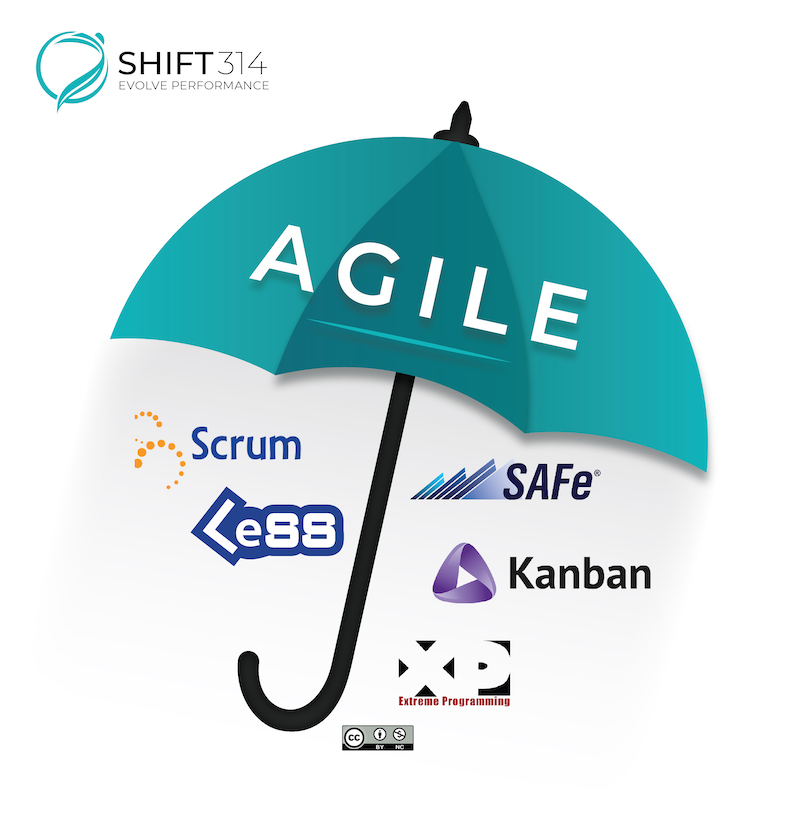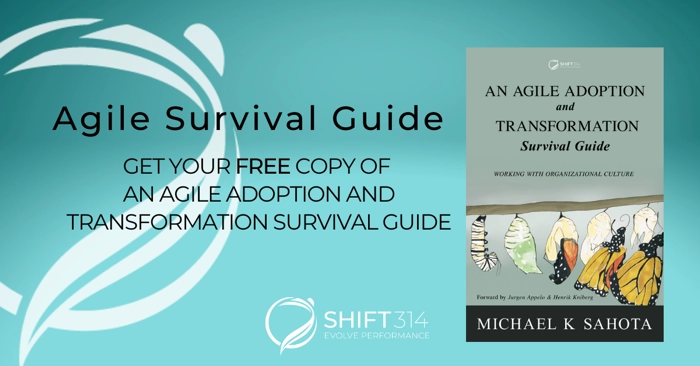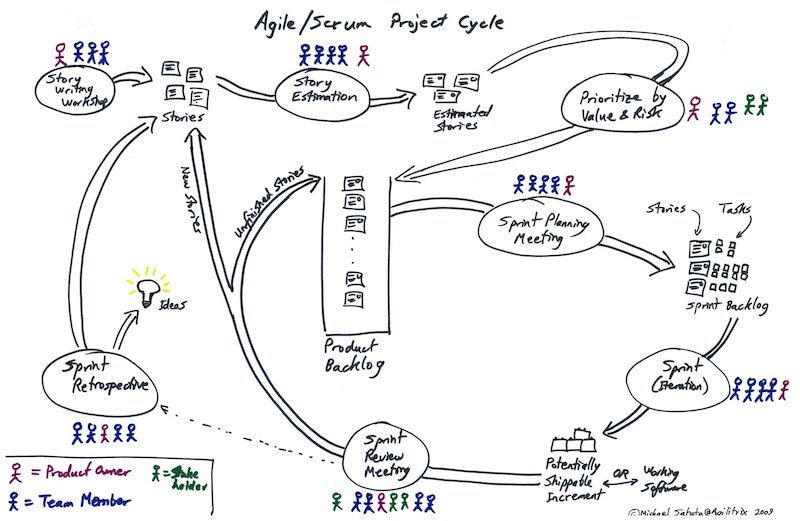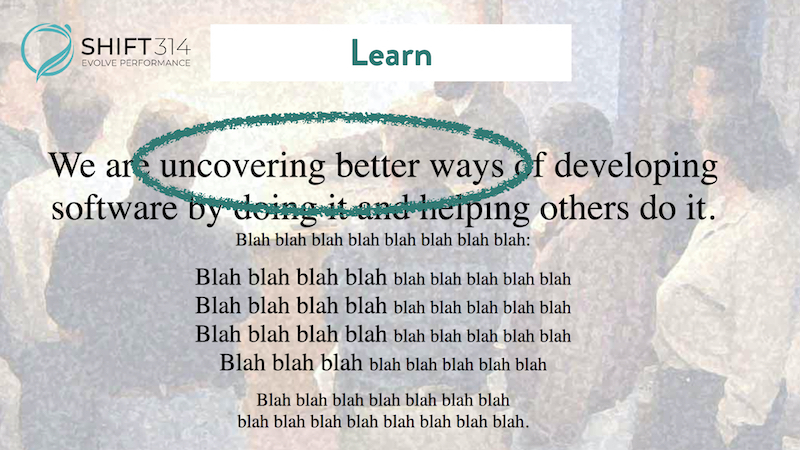If Agile is like dessert, Scrum is like ice cream. The phrase “Agile vs Scrum,” is a bit of a false dichotomy. Scrum is a subset of Agile, just as ice cream is a type of dessert. And Scrum is a very specific kind of dessert – say, vanilla ice cream. It’s this really popular way of doing dessert – or in this case, doing Agile. And that’s where people can get confused.
Just because you’ve experienced Scrum doesn’t necessarily mean you’ve experienced the potential of Agile. In fact, there’s a whole big world of dessert out there. There’s baklava. There’s cake. There’s mousse. There are so many different kinds of dessert and ways to create amazing tasting things that are not ice cream, right? Agile and Scrum work the same way.
While Scrum is a subset of Agile, it’s possible to use the structures of Scrum without getting the benefits of Agile. Thus, it’s vital to understand the distinctions between Agile vs Scrum.

Agile Is a Philosophy
The Agile manifesto defines what Agile is. At its core, Agile really has nothing to do with software. Really, when we boil it all down, the Agile manifesto is saying, “Hey, wouldn’t it be useful if we worked together to create success? Wouldn’t it be useful if we learned? Wouldn’t it be useful if we responded to change?” Those are the basics of Agile, and while there are other words surrounding those points, that’s almost all there is to it.
- What if we learn?
- What if we cocreate?
- What if we adapt?
When we look at Agile that way, we realize Agile is actually pointing to a culture system. It is pointing from a traditional way of working to an evolutionary or higher-performance way of working.

Agile was developed from a collection of what people called “lightweight process frameworks.” All the authors of the Agile Manifesto were using different approaches, so they looked at what they all had in common. They realized the common things with all these different lightweight process frameworks are that they were doing things in a much more people-oriented way, they were learning, and they were adapting to change.
The problem with Agile is there is no set of rules to follow.
Scrum is a Process Framework

Scrum is the world’s most popular Agile process framework. Scrum is simple. It basically says, “Hey, did you notice that people perform better when they’re on teams? Well, what if you got a team together and you had them figure out what they need to work on, and you have them go work on it? Wouldn’t that be great?” Scrum gives you the exact, step-by-step mechanics to implement this process.
Scrum is based on core principles. It’s intended to align with Agile: all about people working together and adapting to change as new information comes in. It’s supposed to be about teams learning and saying, “Well, how can we do a better job building this product? How can we do a better job working together?”
The Scrum process framework is really good to help beginners start to understand what it means to move to an Agile way of being an Agile way of working. It’s a set of rules and roles: Scrum Master, Product Owner, Sprints, Retrospectives, Standups, etc. Do this. Do that. Here is how you will work together. Just follow these steps and everything will be great!
Scrum is popular because people understand how to follow rules. And scrum covers all the basic rules. When you’re learning how to drive a car, you want people to tell you exactly what to do: “Turn right, turn left,” With direct clear instructions, we can start to learn what it means to drive a car.

The problem is that people are lost in the details of Scrum and forget or have never learned what Agile is truly about. Agile is more complex. What does it mean to focus on learning, collaborating and adapting? Nice ideas, but what do I actually do?
It’s a paradox. On the one hand people want to be told the steps involved with Agile so they can be more productive, but the whole point is about liberating people so they think for themselves.
The Big Mistake with Agile and Scrum
Ninety percent of the people who have been exposed to Agile through Scrum have missed the whole picture. A lot of people think they’re doing Agile, but they’re actually just using the framework without shifting the culture. However, the high performance of Agile can’t be achieved by just implementing the structures – it also requires a shift in culture and mindset.
Using the framework of Scrum (or any other process framework) without shifting culture is like somebody saying, “I’m going to celebrate Christmas,” and they put up a Christmas tree and put presents underneath but don’t invite anyone to share the holiday with. The structures are there, but the true meaning of Christmas – kindness to other human beings – is lost.

In the same way, you can implement the structures of Agile by using Scrum, but without shifting mindset and culture, you miss out on the real benefits of Agile.
It’s not just Scrum. This is a tragedy of Scrum, of SAFe, and all other process frameworks where people are asked to focus on what’s easy. Because let’s face it: trying to shift culture (and help people shift their mindset to a different way of being) is challenging.
What’s more, most practitioners or consulting companies that help organizations don’t really understand what it takes to introduce or shift to an Agile mindset within the organization in order to shift culture. They just do very structural process-level changes, hoping somehow that’ll create the success they want, but it never does.
Achieving High Performance
Most people start using Agile or Scrum practices because they want higher performance. Ultimately, high performance comes not from copying practices blindly, but from applying them from a deep understanding of their meaning and knowing when to adapt them to stay true to the meaning.

It’s more important to stay true to the meaning than it is to follow a specific practice. This is where for leaders, Scrum is a trap. Any leader can understand how Scrum works in 10 minutes. What’s actually essential for them is to understand the way of being, how they can show up as an Agile leader.
Evolutionary leadership is what is required for a leader to undertake to create an environment where Agile can thrive. That’s actually why our whole work is pivoted towards evolutionary leadership instead of Agile leadership, because that’s actually what is needed to create success within organizations. A much broader picture than Agile itself.
3 Steps to Get Agile Working In Your Organization
The million-dollar question is, “How can I get Agile working in my environment?” Maybe you have been using Scrum and it hasn’t been working, or perhaps you’ve been using Agile but haven’t seen the results you wanted.
It all comes back to the three essential points in the Agile Manifesto. We’ll give you a simple, actionable step you can take for each of the essential parts of the Agile manifesto.
Learn

Are you fully modeling an evolved way of leadership? Are you inspiring and supporting people? Or are you getting caught up in the cogs of business as usual, focusing on deadlines and corporate goals, and forgetting to look after the people?
If you are a human being, chances are you are not a perfect leader. In line with the Agile manifesto, you can focus on your own learning and thereby model a culture of learning. Take the time to ask, “How can I function better? How can I learn? How can I grow?” Whether it’s acquiring knowledge, changing your behavior, investing in your own growth and mindset, or collaborating better, commit to learning.
Modeling a culture of learning will have a cascading effect in your organization as others see learning as something that’s valued in the organization. This is the first step towards creating a high-performance culture in an Agile environment.
Cocreate

Ask yourself: “Are my people flourishing? Under my leadership, are people excited, passionate, and delighted to be coming to work? Are they pulling out all the stops to create amazing results?” If the answer’s anything less than “absolutely,” there’s some sort of gap, because that’s the intention of Agile.
The intention for Agile is to create amazing workplaces where people are filled with passion and joy.
A simple way to promote that kind of high performance and fulfillment is to become a better collaborator with people. If Agile’s about people and people working together, how can you work better with people? Where can you be more open to other people’s ideas? Where can you have less attachment to your own ideas? Where can you listen more? Asking questions like these and following through on the answers they elicit will help you become a better collaborator.
Flow

Are you comfortable responding to change? When there’s new information that feels uncomfortable for you, are you ready to respond to it and change what you’re doing if that’s what will serve the system best? Or do you find yourself getting stuck with plans and trying to push and make things happen, thereby creating all sorts of damage? How do you react when you find out a product’s going to take longer?
If someone doesn’t show up for a meeting, do you get frustrated or do you just say, “Oh, they’re not here. Maybe I’ll check in to see where they are and make sure they’re okay. Oh, I now have an hour free. What should I do with my time?” You’re excited and you just move on. That’s what responding to change looks like. Most of us don’t respond very well to change. We actually get bent out of shape and frustrated.
Look at how you’ll respond to change, because that determines the environment you create for people. Instead of reacting from fear, you might say, “Oh wow, what should we do with this new information? How can we incorporate this to come up with a more evolved plan?”



